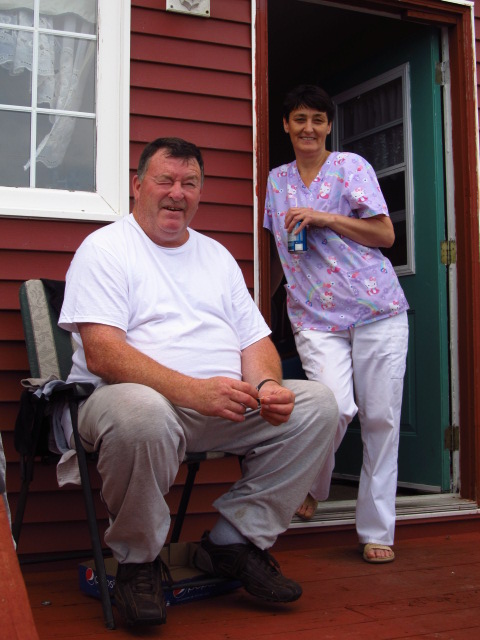
Newfoundland is a scrap of foam blown from the Canadian mainland. It's a rugged, ragged mound of rock, a squiggle in the Atlantic, lying almost due west from Ireland. This means that there is a lot of red hair, a quirky humor in the naming of things: Witless Bay, Dildo, Merrymeeting, Mockbeggar; a haphazard arrangement of streets and "laneways" (no right angles here); and the fact that simply remaining in this place requires a special stubbornness that can only be bred on a similar rocky island.
Before I came, I asked anyone who'd been there: "So, what's Newfoundland like?"
Brows would knit. Eyes would stare off into the distance. "Well... it's different," they would say.
This was disconcerting, not to mention unhelpful. But the island's remoteness and mystery, the fact that, as one person said, "You have to make a commitment to go there," completely drew me in. I had to go there.
So, on a blistering August day, my daughter and I boarded the Atlantic Vision at North Sydney in Nova Scotia for the 14-hour crossing to Argentia. This is a ferry with all the accoutrements of a cruise ship; we watched movies and lounged in the casino. Julia had intimate conversation with a French guy in the Internet room. (The whole boat has wifi.)
Then we landed in Argentia, a bare-knuckle cluster of houses tucked into one of the thousands of bays and coves and inlets and fjords that make up the jagged coastline.
My first look at Newfoundland was through pea-soup fog and relentless wind. Driving down the coast to Cape St. Mary's, I understood the guarded responses from previous visitors. Thick clumps of stunted, windblown spruce alternated with open heath. Or was it marsh? Or bog? Or tundra?
Different. But wasn't that why I'd come?
The Gannett's Nest is a tiny windblown campground and restaurant at the turn-off to Cape St. Mary's Ecological Reserve, which is the third largest nesting colony for northern gannets, murres, kittiwakes and guimots in North America.
The restaurant was busy. A posse of bikers filled several tables.
"How much to camp for the night?" I asked the slim, dark-haired woman with braces. She seemed harried.
"Twurdy."
I handed her $20.
"Twurdy." The word seemed to have stuck in her throat.
"She said thirty," said Julia, whose ears are sharper than mine.
I thought the Newfie accent would be more like an Irish brogue, but it's more like an indescribable mash-up of vowels and swallowing of consonants. Fascinating and incomprehensible.
The restaurant was still jammed that evening, so Julia and I ordered simple meals: fish chowder and moose stew. The same thin woman brought heaping bowls of thick soups, simply seasoned without pretention and loaded with fresh vegetables. It was the best chowder I've ever tasted.
"We make it all ourselves, y'know. Some of those recipes come from our grandmother and great-grandmother," said Martin Foley, owner of the restaurant/campground. "Our family's been here for 300 years, y'know. There's was nutin here when they came.
"But I tink some of 'em was Irish pirates." he winked.
Then he gave us a thumbnail lesson of local botany. Bakeapple berries are growing right behind where our trailer is parked. ("They smell like apple pie when the sun shines.") Cliffberries are Martin's favorite. Then there's partridgeberry, crowberry and squashberry, all growing out there -- somewhere -- on the tundra.
All that night the wind blew. Fog drifted across the marsh like smoke, but the morning dawned clear with glimpses of something like sun. A perfect day for viewing birds.
To get to the bird colony, you drive 13 kilometers on a paved one-and-a-half-lane road to the end of St. Mary's Cape. You must say "Hi!" to Tony in the visitor's center. His big smile and good cheer is contagious, and he loves living in Newfoundland, which is a good thing because his family's been here for 500 years, so I think his people stowed away on the boat with John Cabot, who discovered the place.
Then you walk across the tundra to the Rock. You can hear the birds long before you see them; you can smell them as soon as you get there. Northern gannets, of which there are over 10,000 nesting pairs, are large (six-foot wingspan) white birds that are like ballerinas in the air and like squawking fishwives on land.
Thousands of them cover the rock, each pair with a downy fledgling not quite ready for flight. Birds swoop and cackle. There's a bird pecking order, so to speak. Some ledges are occupied by the gannets; others by the murres; others by the kittiwakes.
It's a bird extravaganza.
You stand 50 feet from the Rock peering into the private life of birds. You watch their territorial squabbles and their family intimacies. You eventually see the dead chicks on the rocks. You distinguish between common and thick-billed murres. You're hungry and you have to pee, but you can't go back. You only leave, finally, when your daughter, who has been photographing birds through binoculars because she forgot her telephoto lens (it works surprisingly well), insists on it.
As you walk back across this windy, barren landscape, you realize that you are falling in love with the place.
